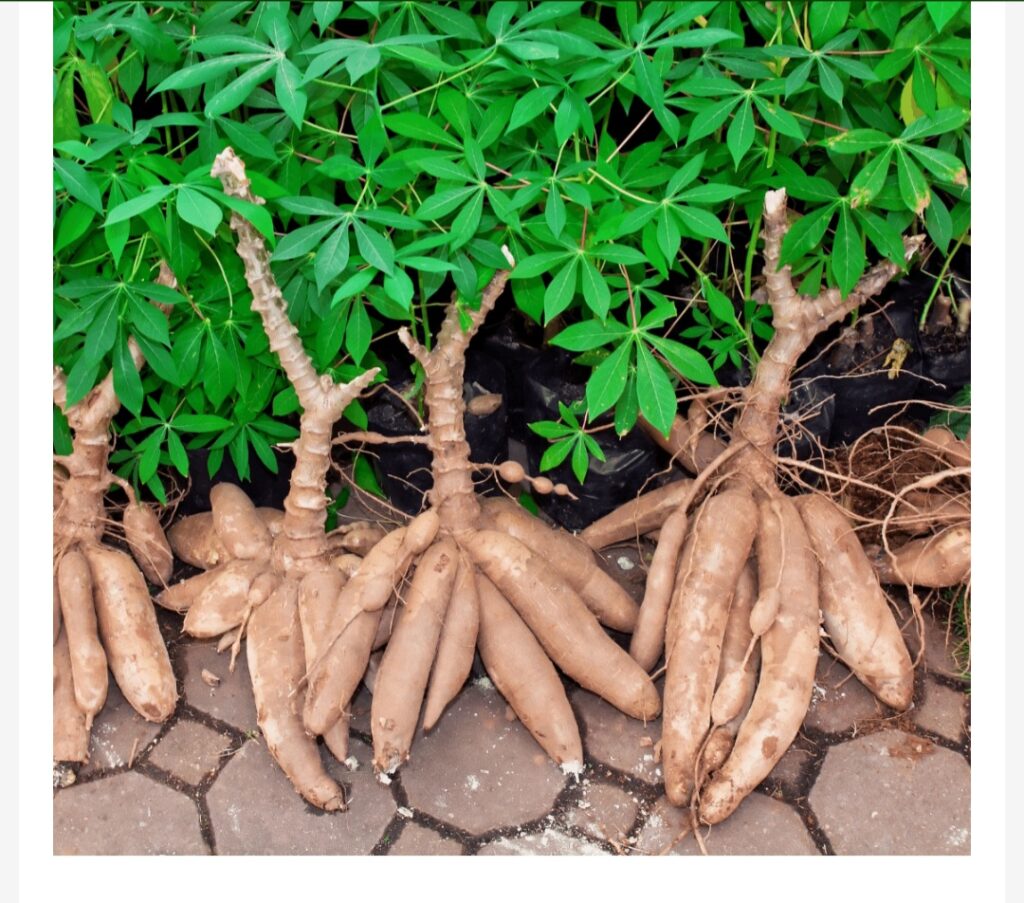
Cassava, (Manihot esculenta) is a tuberous edible plant of the spurge family (Euphorbiaceae) . It is cultivated throughout the tropical and subtropical parts of the world for its tuberous roots. Cassava originated from tropical America and was first introduced into Africa in the Congo basin by the Portuguese around 1558. Cassava probably was first cultivated by the Maya in Yucatán at Mexico. It contain two cyanide-producing sugar derivatives, known as cyanogenic glucosides, occur in varying amounts in most varieties. This cyanides are poisonous therefore, must be removed from cassava tubers.
IMPORTANCE OF CASSAVA.
1. Cassava can be boiled and roasted for human consumption.
2. Cassava peels can be used for ruminant feed
3. Cassava tubers can also be processed to make livestock feed
4. The root is a source of cassava flour, tapioca and laundry starch.
5. The root can also be used for some alcoholic beverages. For example, kasiri that is made by Indians in South America,
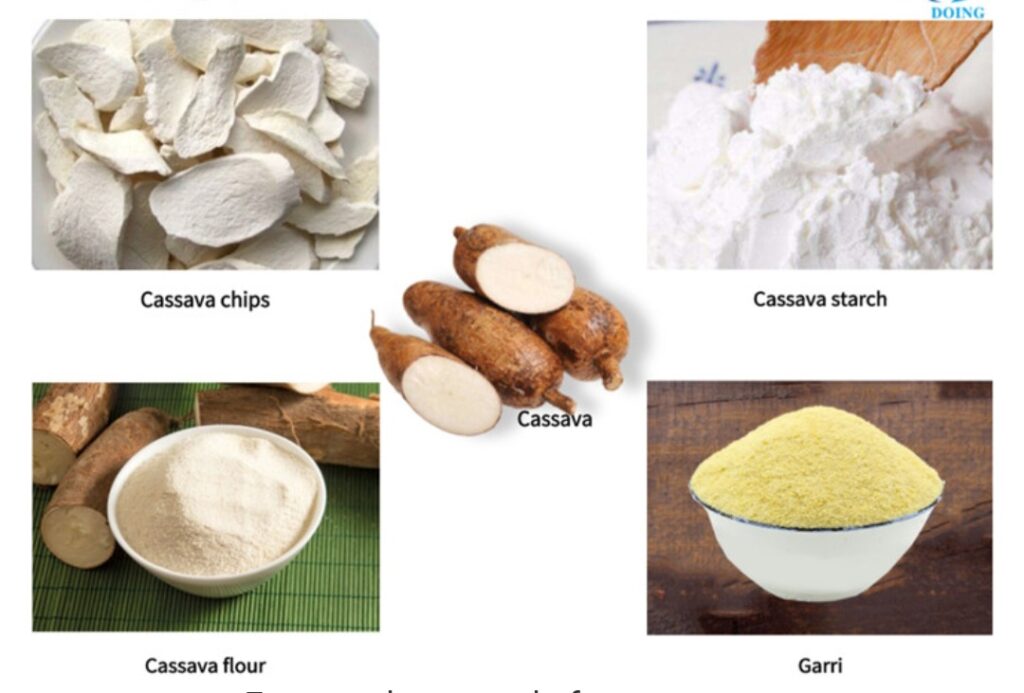
6. Cassava peels can be composted
7. Diabetes: People who eat more cassava flour as part of their diet seem to have a lower risk for developing diabetes.
8. Dehydration in people with diarrhea: Cassava salt solutions can be taken by children orally to treat mild to moderate dehydration caused by diarrhea. However, severe dehydration due to diarrhea causes low levels of electrolytes. Cassava salt solutions do not contain a significant amount of electrolytes. Therefore, these solutions do not seem suitable for treating severe dehydration due to diarrhea.
9. Thyroid disease: Eating cassava might lower levels of thyroid hormones. For people with thyroid disease, especially those needing to use thyroid hormone replacement therapy, eating cassava might make this condition worse.
10. Cassava is a tubercle that is rich in fiber and can help to manage sugar and cholesterol levels in the blood. It can therefore prevent diseases like diabetes, heart attack and stroke, as well as improve intestinal flow.
11. Cassava contains resistant starch, a type of carbohydrate that is not digested and acts similar to fiber in the body. It can therefore feed the beneficial bacteria in the gut and improve digestion.
12. It can also be ingested to prevent conditions like constipation, gastritis or intestinal cancer.
13. Cassava can Prevent cardiovascular diseases
14. Cassava contains potassium and magnesium, minerals that help to eliminate excess sodium in the urine and promote blood vessel relaxation. This can help to prevent high blood pressure.
15. Cassava helps Improve energy and mood. It is high in carbohydrates. The tubercle can be a great dietary addition for people who exercise frequently or work in high-activity jobs, like construction workers, mail delivery, farmers and garbage collectors. The intestinal bacteria in the gut, which promotes the production of serotonin, which is a neurotransmitter is responsible for mood regulation and overall wellbeing.
16. Promoting skin, nail and hair health. Cassava is a source of vitamin C, which is a nutrient that helps to boost collagen production and absorption. This can help to improve skin and hair elasticity, as well as strengthen the nails.
17. It strengthen the immune system. Cassava contains vitamin A, vitamin C and carotenoids (which are components with potent antioxidant action), cassava can help to strengthen immune system cells against infection. This can help to prevent the development of allergies, colds and flu.
18. Preventing some types of cancer. Cassava is a rich source of flavonoids, carotenoids and vitamin C (which are components with antioxidant action), cassava can help to combat excess free radicals and strengthen the immune system. This can help to prevent some types of cancer, like intestinal, stomach and breast cancers.
19. Foods that can be made from cassava include: bread, which can contain cassava flour only or both cassava and wheat flour, french fries, mashed cassava, cassava chips, cassava cake, yuca con mojo, a Cuban dish that combines cassava with a sauce comprising citrus juices, garlic, onion, cilantro, cumin, and oregano, tapioca, which is a common dessert food
20. In Nigeria, Food items such as the gelatinous fufu of West Africa and the bammy of Jamaica come from cassava.
21. Cooked cassava leaves can also be eaten and are an important ingredient in soups and stews in parts of Central Africa.
METHOD OF REMOVING THE POISONOUS CYANIDES. The cyanides are removed by complex refining system which involves grating, pressing, and heating the tubers. To safely prepare most small “sweet” varieties for use as a vegetable, the skin should be peeled off, the tubers must be well cooked, and the cooking water drained off. Some cassava tubers are also soaked beforehand to leach the harmful chemicals. The preparation of cassava flour is usually from larger “bitter” roots, which require significant work to remove the poisons, and can include long soaking times, fermentation, and exposing the cassava paste to the air for several hours.
BENEFITS AND EFFECTS OF THE CYANIDES. 1. The poison (hydrocyanic acid) has been used for darts and arrows.
2. Improper processing of the cassava can cause acute cyanide intoxication
3. A long-term exposure to the cyanogenic glucosides is associated with goitres, chronic pancreatitis, and a nerve disorder known as ataxic neuropathy.
DESCRIPTION OF CASSAVA PLANT
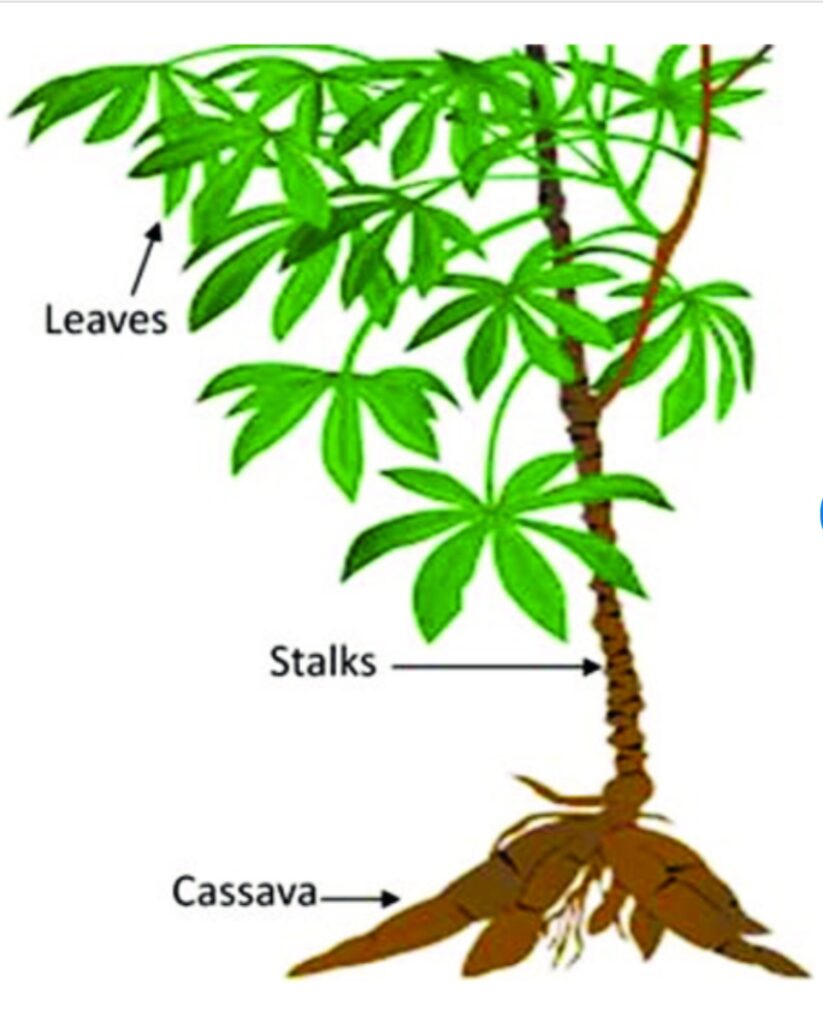
CASSAVA STEM: Cassava stems are cylindrical, with a diameter ranging from 2 to 6 cm. Stems can grow up to 4 m, though stems of some genotypes grow to only 1 m. Stems vary considerably in colour, ranging from whitish gray to brown or dark brown and are usually woody with a large pith.
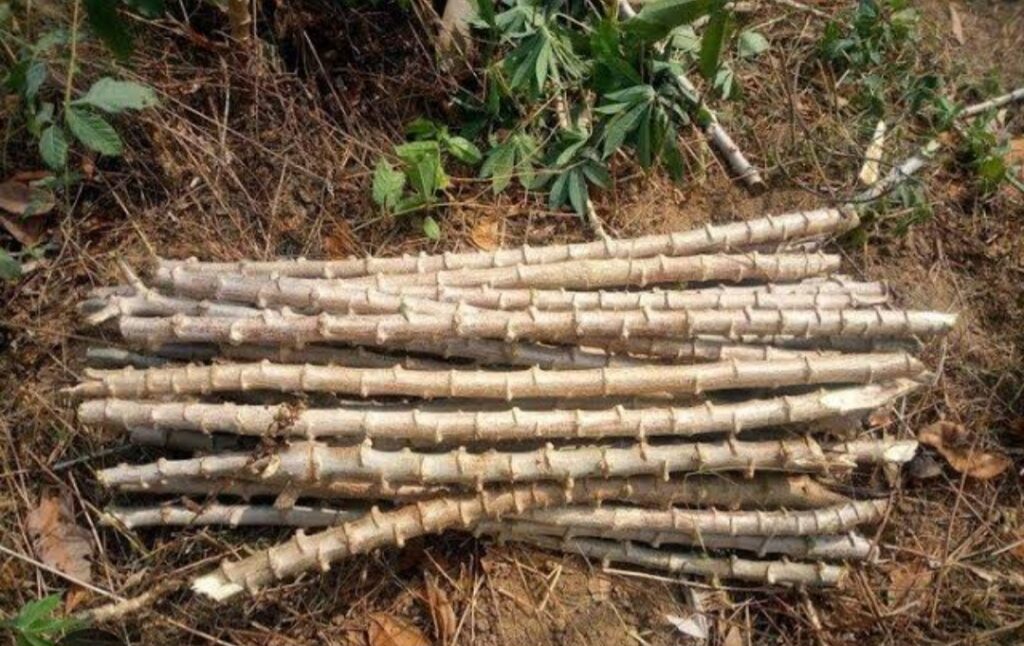
CASSAVA LEAVES: Cassava is a perennial plant with conspicuous, almost palmate (fan-shaped) leaves resembling those of the related castor-oil plant but more deeply parted into five to nine lobes. CASSAVA ROOTS: The edible roots of the plant are usually cylindrical and tapered and are white, brown or reddish in colour. They are fleshy, reminiscent of dahlia tubers.
VARIETIES: There are many varieties of cassava cultivated all over the tropics. The varieties can be differentiated by their height, colour of the stem, colour of the petiole, late or early maturity, yield and colour of skin of the roots.The different varieties range from low herbs to branching shrubs and slender unbranched trees. Some are adapted to dry areas of alkaline soil and others to acid mud banks along rivers. Cassava varieties can be grouped into two based on their species. The bitter varieties ( Manihot utilissima) and the sweet varieties ( Manihot plamata). The bitter variety contains Prussia acid either free or combined as a constituent of the glycoside linamarine. While the sweet variety is considered to be free from this glycoside. Both the sweet and bitter cassava varieties contain hydrocyanic acid or Prussia acid. Although, this acid concentrate in the peel of the sweet varieties and it is removed by peeling.When choosing varieties for planting, improved disease resistant varieties of cassava should be selected.
AGRONOMY OF CASSAVACLIMATIC REQUIREMENT: The cassava crop grows well in areas that are humid and moist. Low temperature causes slow growth and reduced yields. It grows well is in humid-warm weather at a temperature of 25-29 °C (77-84 °F) and the soil temperature of 30 °C (86 °F) is required. Cassava can only grow better in regions or areas that are frost free.In warm weather conditions, it may take cassava plants up to 8 months to produce cassava tubers for harvesting. During extreme weather conditions like the dry or cold season, producing cassava tubers may take 18 or more months. That is, cassava plants begin to experience a decline in growth if the soil temperature falls below 10 °C (50 °F).
SOIL REQUIREMENT: Cassava is a staple food crop capable of producing high yield under conditions of poor fertility and rainfall. Because of this, improved production techniques are often taken for granted. With some improvement over traditional methods, higher yields can be achieved. Cassava can tolerate poor soils but does very well on well drained , rich and friable soils.
CASSAVA PRODUCTION SYSTEM. Traditionally, cassava are cultivated under shifting cultivation system. But under permanent systems, some conditions are needed to be met. Such conditions include:
1. The techniques used must be able to conserve the soil and maintain soil fertility. That is, conservation against erosion, rotation with cover crops, and use of fertilizers whether organic or inorganic.
2. control of weeds
3. Mechanized operations should be carried out to some extent
LAND PREPARATION; The land should be ploughed up, soil should be tilled and mounds, or ridges or plant on the flat after ploughing.In most traditional cropping system, cassava is intercropped with cereals such as maize, rice, grain legumes in the first three months after planting.
PLANTING: Cassava is propagated by stem cutting. The cuttings should be 20 -30mm in lenght. Each cutting should carry about 4 – 6 buds. The cuttings are planted in the soil either horizontally or slanting at an angle of 45 degree with the buds facing up. The cuttings can be taken from the stem of a matured growing cassava or from harvested or about to be harvested cassava stem. The best cuttings come from the middle portions of the stem. The stems also should be taken from plants with no sign of mosaic virus or bacteria blight. Cassava can be planted during the rainy season or late rainy season so that the plant can be established before the late rains stop.Cuttings that are planted flat produces smaller tuber than upright cuttings, but there are more of them and they are less bunched together. Cuttings that are completely buried are less liable to sry out if there is a risk of drought at planting. Mechanized planting can also be used. The planter plant the cuttings in an horizontal manner.
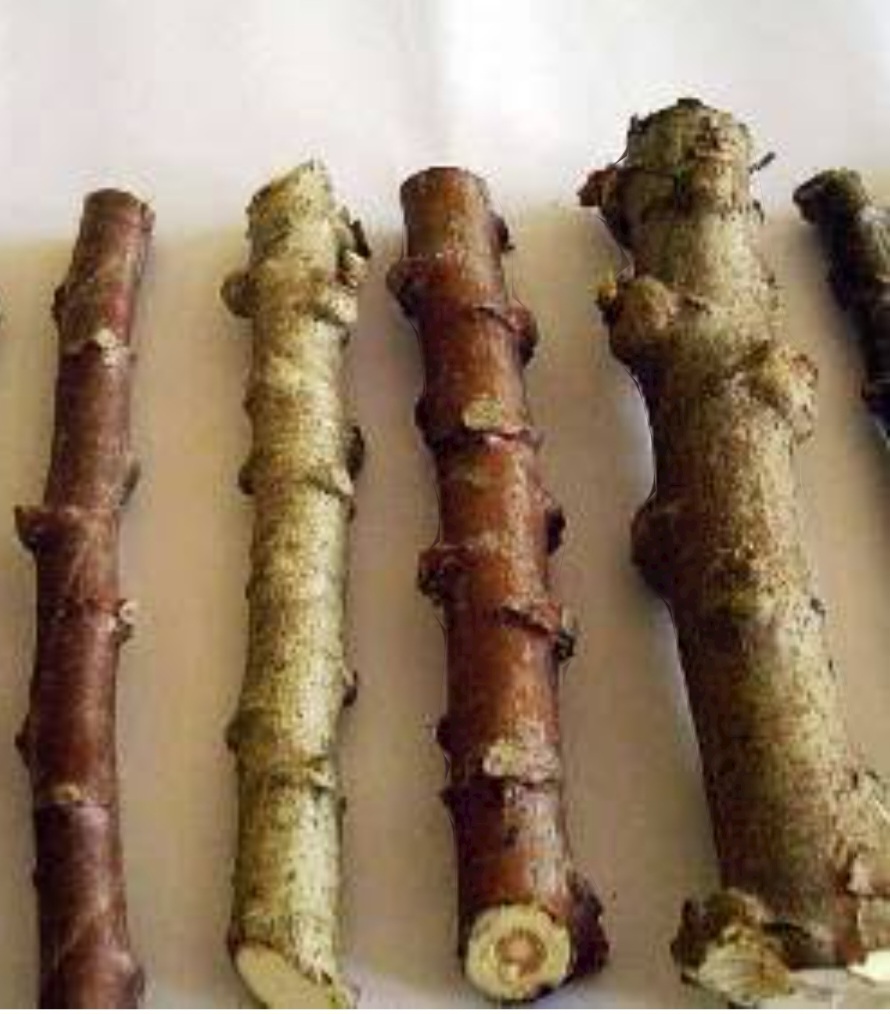
CROP ROTATION; Cassava can be rotated with crops like maize, cowpea, soybeans, groundnuts, etc. Also cassava can be planted inbetween coconut trees and some other plantation crops due to their large spacing.
SPACING: For sole cassava planting, a spacing of 100×100cm is recommended. For mixed cropping, a planting space of 200×50cm is recommended . Optimum spacing is between 80 ×100cm or 100× 100cm in the tropical rainforest.
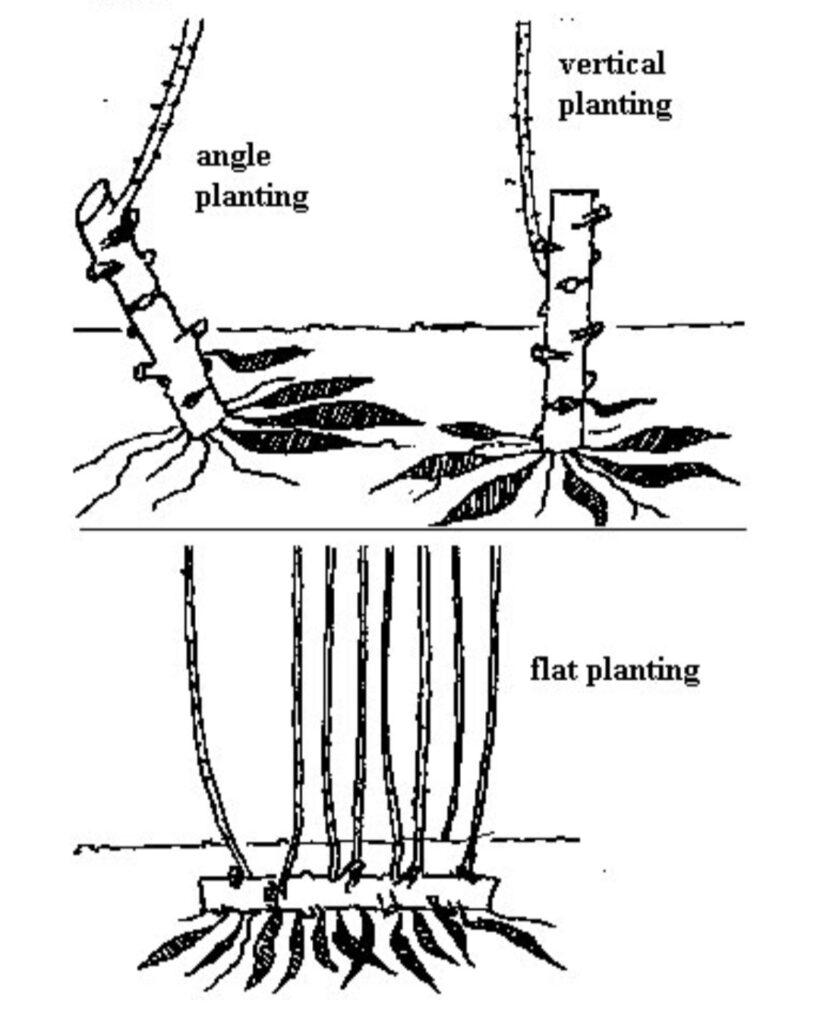
WEED CONTROL: Weeds on cassava farm can be controlled mechanically, chemically or by combination of both. Mechanical weed control can be done twice or three times through out the crop life cycle. For chemical weed control on cassava farm, the herbicides can be applied prior before planting or immediately after planting but must not be applied during germination. But if application will be done during germination, the herbicides should be applied directly on the weeds but should not be applied to touch the propagules and the leaves growing on the cuttings.
FERTILIZER APPLICATION; On poor soils, cassava respond favorably to nitrogen and potassium fertilizers. In rich soils, especially potassium rich soils, there is no need to supply potassium in the early growing years.In crop rotation, if legumes are included, nitrogen application must be lower than the amount used by the crop. If the soil is moderately rich in nutrient and legumes are ploughed in, then about 10kg NPK 10;10; 20 can be applied for each tonne of tuber. Ideally, nitrogen and phosphorus should be applied after the cuttings have been planted. After much vegetative growth, fertilizer application may be difficult either by hand or mechanically. Therefore, it is recommended that fertilizers be applied as land is being prepared. The fertilizers can be applied by placement method close to the cuttings. It can also be broadcasted in the case of a deficiency symptom.
MATURITY AND HARVESTING: Cassava stays on the field for up to a year or more depending on the variety. It is usually harvested 9-12 months after planting. Harvesting can be done manually or mechanically. The mechanical harvesting can be done using the dingle row harvester. To harvest cassava, the tubers are uprooted from the ground. A yield of 15 – 45 tons/hectare can be realized depending on the variety.
PEST AND DISEASES OF CASSAVA. PESTS: Some common leaf and stem pests of cassava include:cassava mealybug ,cassava green mite, grasshoppers, and whiteflies
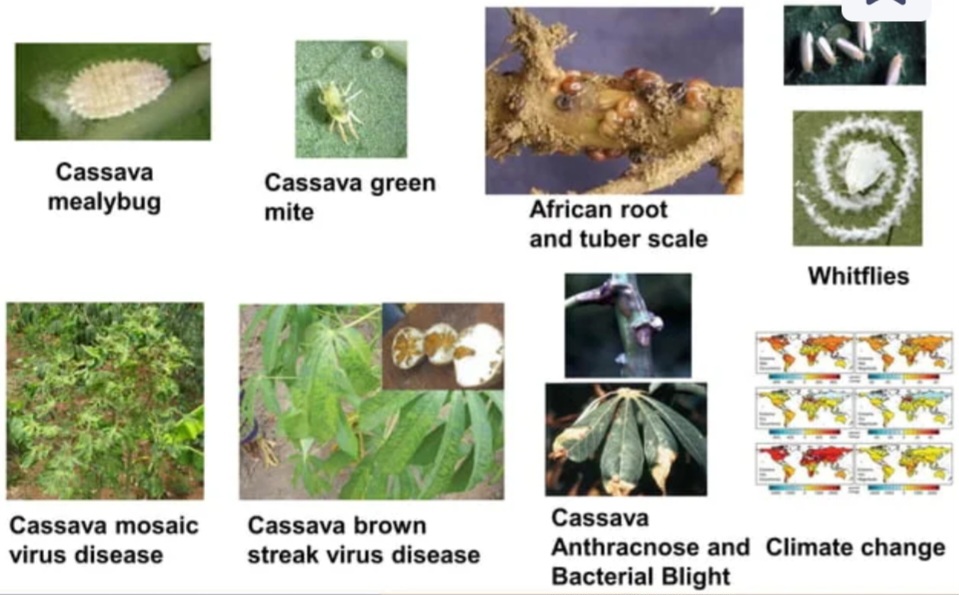
a. Cassava mealybug (Phenacoccus manihoti), feeds on cassava plants, the leaves and the stems in particular. There are two kinds of cassava mealy bugs. The green mealybug, (Phenacoccus madeirensis), and the striped mealybug, (Ferrisia virgate). The green mealybug is more common on cassava than the striped mealybug, the striped mealybug occurs mostly on surfaces of cassava stems. The green mealybug and striped mealybug feed on cassava only and do not feed on other food crops. They are commonly found at cassava shoot tips under the surfaces of leaves. This pest injects a toxin into the leave of the cassava plant resulting in leaf withering, and the cassava’s growth becomes stunted. This can result in a considerable loss of crop yields of over 60%.
b. Cassava green mite ( Mononychellus progresivus Doreste): is one of the most destructive pests across the African continent especially in Nigeria. It reduces cassava tuber yields by 14-80%. This pest thrives in the wet season. They affect cassava leaves and shoots tips . Cassava green mite pest affects young leaves, and red mite attacks older leaves. Red mites are not common and do not cause serious damage to cassava crops . Cassava green mite causes tiny yellow chlorotic spots on the upper leaf surfaces. The damage to cassava crops by cassava green mites is more severe in the dry than in the wet season.
c. Variegated grasshopper( Zonocerus variegatus), belongs to the same order (Orthoptera) as locusts. The Variegated grasshopper is the main grasshopper pest that attacks cassava. It is one of the important pests that cause yield loss in cassava produce. The variegated grasshopper feeds on cassava leaves and stems. This pest defoliates the stem, and damage is more common on older cassava crops than on younger cassava plants and is more severe in the dry than in the wet season.
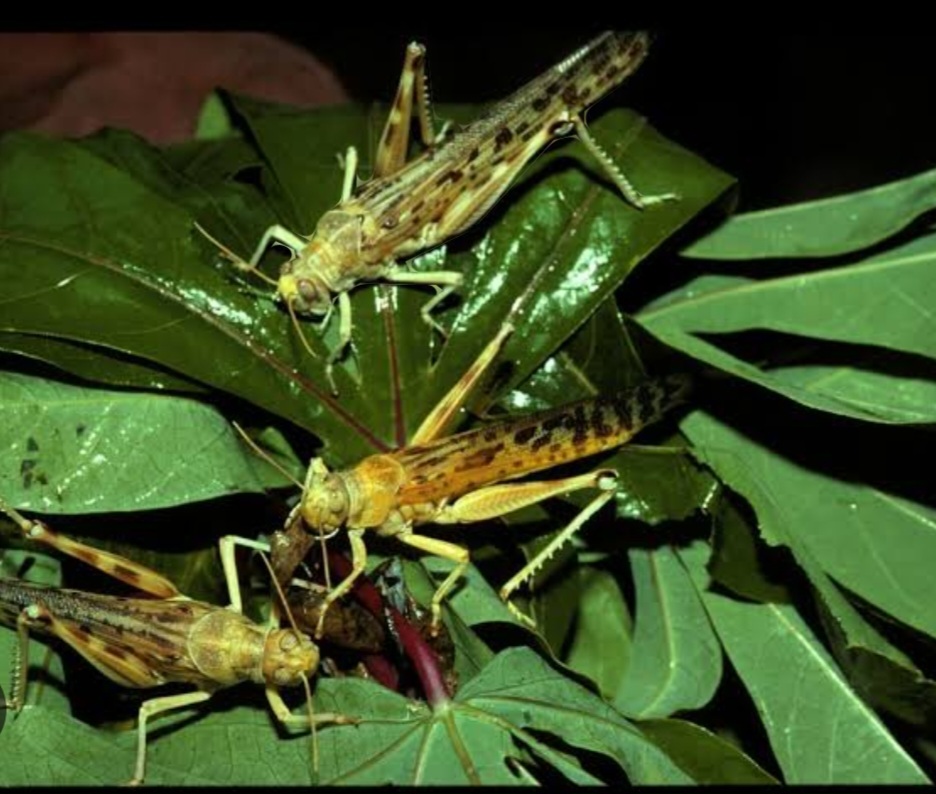
d. Whiteflies (Bemisia tabaci): It causes low productivity of cassava in Africa especially in Nigeria. Whiteflies suck sap from the leaves. They are responsible for transmitting plant viruses that can cause physical damage to cassava and a vector for disease. The pest injects the plant with viruses which cause cassava mosaic disease (CMD) and cassava brown streak disease (CBSD). Whiteflies transmit the following viruses: Begomovirus, pomovirus, Carlavirus and Torradovirus etc. CONTROL OF CASSAVA PESTS. Treating cassava with pesticides to control pests and diseases is not adviceable. But crop protection measures are encouraged to be practiced. The cuttings should be treated, plant improved varieties, high yielding varieties, disease resistant varieties, and selection of healthy matured cuttings. Early planting at the onset of rains should be practiced, crop rotation. Use biological control through using predatory mites and parasites. Use integrated Pest Management is also highly advisable
DISEASE.
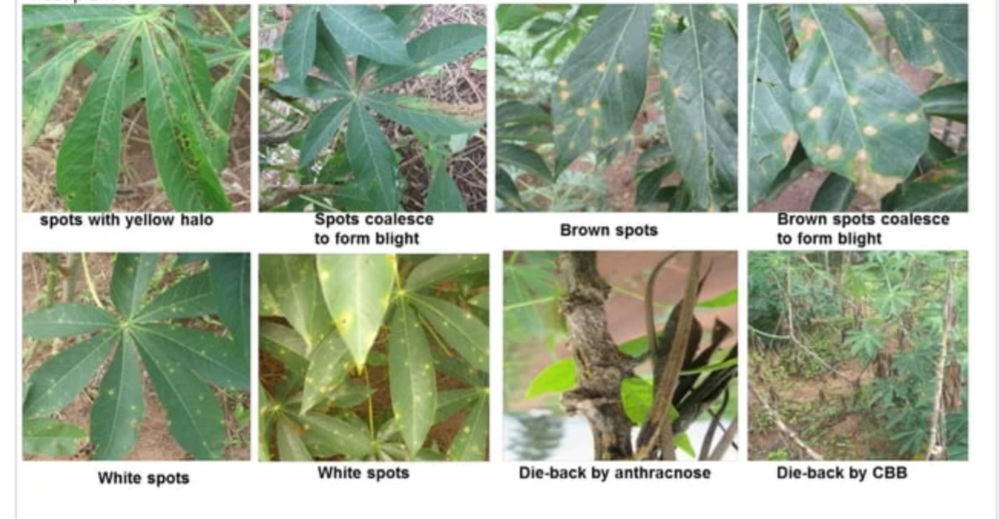
a. Bacterial blight: bacteria blight, can be treated using balanced fertilizers. Also, good crop management should be practiced. b. Cassava mosaic disease (CMD): This disease is caused by cassava mosaic begomoviruses (genus Begomovirus, family Geminiviridae). The whitefly is the vector that transmits the disease, which can be caused by using infected cassava cuttings as planting materials. Cassava mosaic disease (CMD) is a primary threat to cassava cultivation in Africa, Nigeria in particular. They result in yield reductions (cassava tubers). Cassava plants affected by this disease in the early growth stage can be more severe and devastating than in the later stage of development. The disease manifests on the leaf leading to leaf reduction and leaf chlorosis. This could lead to a huge yield loss causing economic losses to the farmers. Symptoms of cassava mosaic disease: Yellowing and distortion of leaves, Stunted growth, Misshapen and twisted leaves, reduction in the size of leaves and plants etc. Other diseases of cassava include: Venial necrosis, Brown streaks on the stem, Necrotic dry rot on the roots. etc. Control. Planting cuttings from disease free stem, plant disease resistant variety cuttings.
